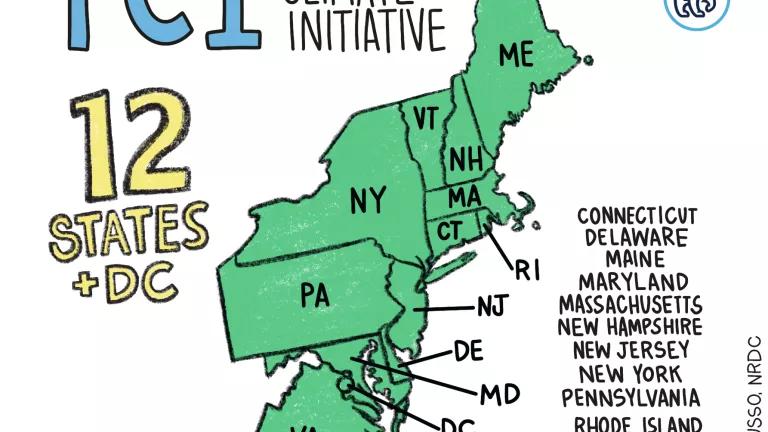FERC Storage Rule a Win for a More Flexible Grid

The Federal Energy Regulatory Commission (FERC), the agency overseeing the competitiveness of the wholesale electricity markets and high-voltage interstate transmission grid operators, has finalized a rule that reduces barriers to electric storage resources to compete in those markets. Electric storage resources, like batteries, can absorb and store cheap electricity generated by wind and solar power for later injection back into the grid when there is less sunshine and wind and electricity generation is more expensive. This rule will facilitate storage's ability to contribute to a more flexible and clean transmission grid.
FERC’s new rule requires the regional grid operators it regulates to revisit their market participation rules to account for storage's characteristics as distinguished from incumbent market players like traditional power plants. Because storage resources can both inject and receive electricity into and from the grid, the rule allows storage to participate as supply, demand, or both and not just as one or the other, which limits the value storage can offer.
FERC’s new rule applies to storage resources as small as 100,000 watts and these resources may be sited on the local, low-voltage distribution grid.

Electricity storage devices can be smaller than 100,000 watts, however. And distributed energy resources (DERs), like electric vehicles and water heaters plugged into the grid as well as rooftop solar panels, can also provide similar benefits as larger storage resources.
In its proposed rule, FERC had also proposed that DERs could combine (or “aggregate”) to participate in wholesale markets. Aggregation is critical to smaller DERs’ ability to compete in the markets, and FERC’s proposal provided a framework for regional grid operators to develop rules tailored to their respective regions and states. FERC’s proposal was similar to the existing framework that FERC had approved for CAISO, the regional grid operator for California.
Despite the evidence in support of the proposed rule for DERs, FERC ultimately declined to finalize it before gathering more information. Until FERC takes further action eliminating barriers preventing DERs from competing in wholesale markets, the vast network of smaller resources that could cost-effectively provide wholesale market services will remain largely untapped.
Why is it important to enable DERs to participate in the market in a timely manner?
There are many benefits—as well as barriers—to DERs participating in the wholesale markets. DERs tend to be sited close to where electricity is consumed, which can reduce energy loss in transport, avoid costly grid infrastructure enhancements, displace rarely-used and polluting generators, and mitigate the risk of transmission failing along the way. As early as 2007, the Department of Energy had recognized the “resilience”-related benefits of DERs (e.g., in keeping the electricity on during extreme storms), while noting that non-uniform regulation is a barrier to their development.
As DERs increase their presence on the grid, consumers could save by tapping into these resources’ potential for low-cost grid services when these resources would otherwise be sitting idle or underused. For example, 36 percent of DER generating capacity currently cannot be used in PJM because market rules do not permit DERs to inject electricity into the grid unless they register like power plants do.

DER penetration in most FERC-regulated markets is currently low, but DERs are proliferating (e.g., electric vehicles have grown in sales by 30 percent to 40 percent annually). A failure to plan now to integrate them onto the transmission grid is likely to create a more complex situation later when these resources reach significant penetrations. In fact, the FERC study on DERs released concurrently with FERC’s final rule pointed to an European event in 2006 where high penetrations of DERs uncoordinated with transmission operations exacerbated a blackout. FERC’s review highlighted the need to provide transmission grid operators with more information about DERs on the distribution system. Enabling DERs to participate in wholesale markets would help accomplish this.

Source: FERC, citing Navigant
And while DERs participating in the wholesale markets will require additional modeling, planning, and coordination between the transmission and distribution grid operators, these efforts are underway. FERC, the Electric Power Research Institute, the National Labs, North American Electric Reliability Corporation, the National Institute of Standards and Technology, and stakeholders have already begun to address them (see also here). FERC’s study shows that integrating DERs at their current or somewhat higher penetrations would not cause an outage or require emergency energy deployment. FERC also recognized that better forecasting as well as implementing smart inverters and other advanced technologies would help avoid issues that could arise at higher penetrations. FERC’s proposed DER rule allows for regional grid operators to work with their stakeholders to address these issues while ensuring that progress enabling DERs to provide grid benefits continues.
What are the next steps?
Regional grid operators will now revisit their market rules to ensure that electric storage resources can offer all of the grid services for which they are technically capable. Grid operators must file their region-specific storage rules 360 days after FERC’s final rule is published in the Federal Register, and they have another year to implement the new regional rules.
As to DERs, FERC will host a public forum on April 10-11 to gather information. FERC has posed some very thoughtful questions, but an important question not asked is which of these issues must be resolved prior to FERC establishing a framework to remove barriers and spur region-specific rule development for DER participation, and what is a reasonable timeline for their resolution? Notably, FERC had approved a similar rule for CAISO prior to working out the answers to the listed questions, and no problem has arisen there.
We look forward to the next steps and to working with regional grid operators, stakeholders, and FERC to modernize the grid to be more flexible and efficient by expeditiously developing a sound final rule for DERs.



